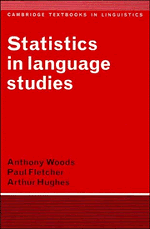Book contents
- Frontmatter
- Contents
- Preface
- 1 Why do linguists need statistics?
- 2 Tables and graphs
- 3 Summary measures
- 4 Statistical inference
- 5 Probability
- 6 Modelling statistical populations
- 7 Estimating from samples
- 8 Testing hypotheses about population values
- 9 Testing the fit of models to data
- 10 Measuring the degree of interdependence between two variables
- 11 Testing for differences between two populations
- 12 Analysis of variance – ANOVA
- 13 Linear regression
- 14 Searching for groups and clusters
- 15 Principal components analysis and factor analysis
- Appendix A Statistical tables
- Appendix B Statistical computation
- Appendix C Answers to some of the exercises
- References
- Index
4 - Statistical inference
Published online by Cambridge University Press: 05 June 2012
- Frontmatter
- Contents
- Preface
- 1 Why do linguists need statistics?
- 2 Tables and graphs
- 3 Summary measures
- 4 Statistical inference
- 5 Probability
- 6 Modelling statistical populations
- 7 Estimating from samples
- 8 Testing hypotheses about population values
- 9 Testing the fit of models to data
- 10 Measuring the degree of interdependence between two variables
- 11 Testing for differences between two populations
- 12 Analysis of variance – ANOVA
- 13 Linear regression
- 14 Searching for groups and clusters
- 15 Principal components analysis and factor analysis
- Appendix A Statistical tables
- Appendix B Statistical computation
- Appendix C Answers to some of the exercises
- References
- Index
Summary
The problem
Until now we have been considering how to describe or summarise a set of data considered simply as an object in its own right. Very often we want to do more than this: we wish to use a collection of observed values to make inferences about a larger set of potential values; we would like to consider a particular set of data we have obtained as representing a larger class. It turns out that to accomplish this is by no means straightforward. What is more, an exhaustive treatment of the difficulties involved is beyond the scope of this book. In this chapter we can only provide the reader with a general outline of the problem of making inferences from observed values. A full understanding of this exposition will depend to some degree on familiarity with the content of later chapters. For this reason we suggest that this chapter is first read to obtain a general grasp of the problem, and returned to later for re-reading in the light of subsequent chapters.
We will illustrate the problem of inference by introducing some of the cases which we will analyse in greater detail in the chapters to come. One, for example, in chapter 8, concerns the size of the comprehension vocabulary of British children between 6 and 7 years of age. It is obviously not possible, for practical reasons, to test all British children of this age.
- Type
- Chapter
- Information
- Statistics in Language Studies , pp. 48 - 58Publisher: Cambridge University PressPrint publication year: 1986



